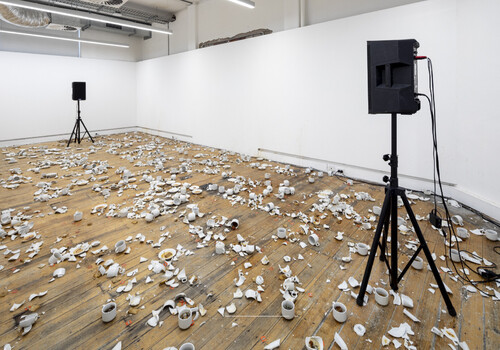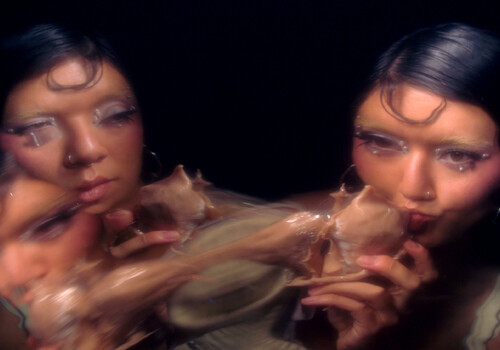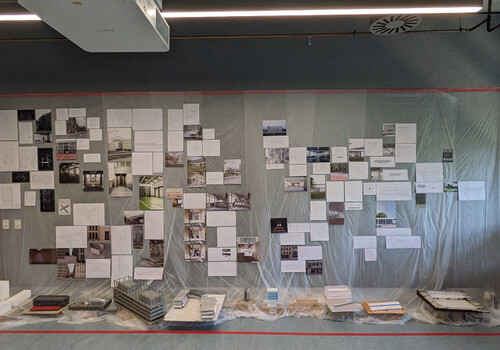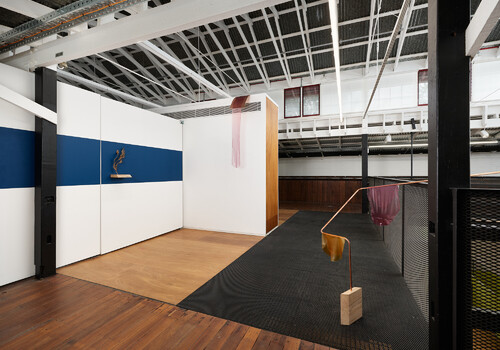Painting, Victorian College of the Arts
By Pru Anderson
Three canvas panels are cinched in their top corners by rough metal hooks, strung up to the ceiling with rope and hanging like pieces of meat. Both sides of the panels feature oil paintings of galaxies, oysters with pearls, assorted viscera and… wait, is that from a Daft Punk music video? Hunter Smith’s Messier 87, Fifo and Around the World combine the cosmic vastness of space with the alien-ness of nature and the body. Messier 87’s black hole is framed on both sides by the grotesque fleshiness of oyster meat. On the work’s reverse, an ultrasound is tipped on its side and paired with what appears to be a close-up study of an oyster shell containing a pearl. The images may seem unlikely bedfellows, but they are united by a shared sense of form, the ripples of the ultrasound mirroring the intricacies of the oyster meat’s grooves and furrows. Similarly, the explosive titular Messier 87, a supergiant elliptical galaxy, recalls both the oyster’s connective tissue, and also the glimmering pearl that lies at its centre. I’m reminded of the Fibonacci sequence’s recurrence in nature, governing the patterns of growth of some natural objects—from the leaves on trees to arms of spiral galaxies.

Installation view of Hunter Smith, Messier 87, Fifo, Around the world, 2024, oil on canvas, polyester rope, hooks. Victorian College of the Arts, Melbourne. Photo: Pru Anderson
This unification of nature is reflected in Fifo and Around the World,which feature, among other cross-sections of oyster, frames from Daft Punk’s 1997 Around the World music video. The video is famous for its cyclical and precise choreography, depicting various dancers dressed as mummies, synchronised swimmers, skeletons, and retro-futuristic astronauts ascending and descending stairs arranged in a semicircle. The repeated mantra (metallic droning) of ‘Around the World’ speaks to a unity among all things on earth, giving the impression of a shared experience that can connect something as small as an oyster shell to something as complex as a black hole.

Hunter Smith, Around the world, Fifo, Messier 87, 2024, oil on canvas, polyester rope, hooks. Victorian College of the Arts, Melbourne. Photo: courtesy of the University of Melbourne
A similar sense of unity in corporeality is present in Sophie Leggatt’s Vertebrae (Mastodon), a series of painted plywood canvases in the shape of vertebrae grasped by disembodied hands. As I follow the sequence of works along the wall, both the hands and the vertebrae oscillate between different levels of detail, until the same motif is halved on the final work. If not for the adjacent wall label specifying the vertebrae as taken from the extinct Mastodon, I would have taken the bone to be from a human skeleton. Its decaying painted resemblance feels elegiac, its vibrancy fading in and out. It’s a kind of reminder of life’s fragility; we hold up fossils as objects of curiosity and study, forgetting their status as memento mori. On the adjacent wall above the canvases, two dark birds fly in tandem. Perhaps they are an omen of death or rather a symbol of hope and vitality. Or maybe they can be both.

Installation view of Sophie Leggatt, Vertebrae (Mastadon), 2024, oil paint, canvas, plywood. Victorian College of the Arts, Melbourne. Photo: courtesy of the University of Melbourne
Hunter Smith’s and Sophie Leggatt’s works are a return to fundamentals of nature in the face of ugliness and decay. While rejecting the shallow trappings of “hopecore”, they remind me that while from dust I came and to dust I will return, at least this is the same dust that composes everything from something as mighty as an extinct mammoth or a supergiant galaxy to something as small as an oyster shell. Now isn’t that a nice thought?
Pru Anderson is an Art History and English and Theatre Studies student from Naarm









































